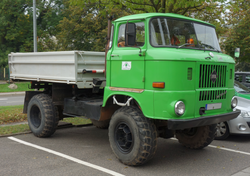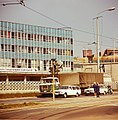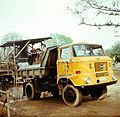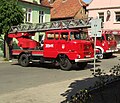IFA W50
| IFA | |
|---|---|
|
W50 LA
|
|
| W50 | |
| Manufacturer: | Automobilwerke Ludwigsfelde |
| Production period: | 1965-1990 |
| Previous model: | IFA S4000-1 |
| Successor: | IFA L60 |
| Technical specifications | |
| Designs: | Forward control |
| Engines: | R4 diesel engine 4 VD 14.5 / 12-1 SRW ; 6.56 l |
| Power: | 81-92 kW |
| Length: | 5300 mm |
| Width: | 2500 mm |
| Height: | 2630 mm |
| Wheelbase: | 3200 mm |
| Turning circle: | 14.2 m |
| Payload: | approx. 5 t |
| Perm. Total weight: | 9.8 to 10.2 t |
The W50 ( W erdau 50 dt ) is a multi-purpose lorry of the IFA ( Industrial Association of Vehicle Construction ) built between 1965 and 1990 in the GDR . A total of 571,789 vehicles of this type were built. Production took place at the Ludwigsfelde automobile works , but special vehicles also came from other companies.
The GDR 5 mark banknotes had a picture of this car on the back.
The successor was also in Ludwigsfelde built IFA L60 .
Development history
At the end of 1959, work on a successor to the IFA S4000-1 began in the “Ernst Grube” Werdau motor vehicle plant . As early as 1956, a further development of the IFA H3A truck was being worked on in the VEB Sachsenring Zwickau. Some perspective vehicles and prototypes were created here, for example the S4500. With the relocation of truck production from Zwickau to Werdau, work continued on the prototype in addition to the series production of the S 4000-1. The S4500 became the W45 in 1959. As early as 1961 there was a first prototype, then in 1962 under the name "W45", which largely corresponded to the series version. The public presentation of the prototype before it was launched into series production was unusual for the time. The KFT wrote: “The fact that in the case of the W45 LAF it is already going public at this stage, when the cloak of the greatest secret is still covered about other new developments, is because as many suggestions as possible from future users are to be processed . “Production could not begin until 1965, as the payload had to be increased to five tons. After all, the vehicle should be able to replace not only the S4000-1, but also the G5 and H6 models that were already discontinued with a larger payload . Due to the planned large production figures, a new plant also had to be built as the capacity in Werdau was insufficient. So the W50 was not built in Werdau, but in Ludwigsfelde.
Executions
The W50 was available in a large number of versions, for almost every purpose. Some of them are shown below.
The car slewing crane 70 has a long wheelbase and all-wheel drive.
W50 DL 30 (turntable ladder)
W50 LF 16 , rear-axle driven fire engine
W50 TLF 16 , all-wheel-drive tank pumper
W50 TLF 16 GMK (with shutters)
W50 TLF 16 of the NVA with low pressure tires
Laboratory trolley ( box body )
W50 formerly used for transporting prisoners in the Berlin-Hohenschönhausen Memorial
Production program W50
- (Status: around 1970)
| W50L | |||||||||||||||
|---|---|---|---|---|---|---|---|---|---|---|---|---|---|---|---|
| 3200 mm wheelbase high-pressure tires |
3700 mm wheelbase high-pressure tires |
||||||||||||||
| Flatbed vehicles | Box vehicles | Special vehicles | Dump truck | Tractors and articulated trucks | Flatbed vehicles | Box vehicles | Special vehicles | ||||||||
| L. | Flatbed with / without tarpaulin | L / NKB | Normal box vehicle, for ground load | L / F | Faeces vehicle | L / K 3SK5 | Three-way tipper | L / Z | Road tractor with a flatbed | L / Sp | Freight forwarding platform vehicle with split side wall, with / without tarpaulin frame and tarpaulin | L / MK | Furniture box vehicle with 4-seater driver's cab | L / DL 30 | Turntable ladder DL 30 for a crew of 1 + 5 people |
| LP | Flatbed with hydraulic tail lift, tarpaulin frame and tarpaulin | L / NKP | Normal box vehicle Post | L / U | Universal mounting mast 13m | L / S | Tractor unit without combination requirements | L / L-HDS 3 | Flatbed vehicle with hydraulic loading crane HDS 3 | L / MK-LB | Furniture box vehicle with hydraulic tail lift and 4-seater driver's cab | L / LF 16 | Fire fighting group vehicle LF 16 for fire fighting group 1 + 8 people | ||
| L / BT | Construction crew vehicle with 10-seat driver's cab | L / IKB | Isothermal box vehicle, for ground load | L / KAF | Carcass vehicle | L / S | S. and milk tank trailers (with insulating plastic containers) | L / L-LDK 1250 | Flatbed truck with hydraulic loading crane LDK 1250 | L / LC | Dumpster vehicle with hydraulic loading crane | ||||
| L / IKSt | Nitrogen refrigerated box vehicle, for ground load |
L / RK | Right-hand drive street sweeper | L / S | S. and universal tank trailers (with insulating plastic containers) | L / FPS | Driving school vehicle with double steering and 4-seater cab | ||||||||
| L / W | Workshop box vehicle | L / S | S. with platform trailer for containers and long material | ||||||||||||
| L / S | S. with flatbed trailer, with / without tarpaulin frame and tarpaulin | ||||||||||||||
| L / SM1 | Tractor unit with specific combination requirements | ||||||||||||||
| L / SM1 | S. with compound feed transport trailer | ||||||||||||||
| W 50 LA | |||||||||||||||
| 3200 mm wheelbase high-pressure tires |
3200 mm wheelbase low-pressure tires |
||||||||||||||
| Flatbed vehicles | Special vehicles | Dump truck | Road tractors with tipping bodies | Special vehicles 3700mm | Tractors with tipping bodies | ||||||||||
| LA / P | Flatbed vehicle with all-wheel drive, with / without tarpaulin frame and tarpaulin |
LA / F | All-wheel drive slurry tanker | LA / K 3SK5 | Three-way tipper with all-wheel drive | LA / Z 3SK5 | Road tractor with three-way tipping body, all-wheel drive, 16t towing mass |
LA / TLF 16 | Tank fire engine TLF 16 for fire fighting groups 1 + 5 people, with all-wheel drive | LA / Z 2SK5-ND | Truck with two-way tipping body and all-wheel drive, towing mass 12t | ||||
| LA / K MK 5/6 | Four-wheel drive dump truck | LA / Z 3SK5-ND | Truck with three-way tipping body and all-wheel drive, towing mass 12t | ||||||||||||

Many other variants were created at the customer's request with cooperation partners such as B .:
- VEB IFA bodywork
- VEB Spezialfahrzeugwerk Berlin-Adlershof
- VEB fire extinguisher plant Luckenwalde
- VEB motor vehicle plant "Ernst Grube" Werdau
- VEB rationalization of the Dessau public utility
- PGH Five Towers Halle (Saale)
- PGH Have a good trip Guben
- PGH Fahrzeugbau Kakerbeck
- E. Mühle Söhne KG, Löbau / Saxony
- Schneider KG, Reichenbach in Vogtland
- Karosseriewerk Winter KG, Zittau / Saxony
- Controller manufacturing and mechanical engineering VEB Sachsen Radebeul
The W50 was the most important truck in the GDR . It was manufactured in 60 different basic versions (tipper, box, flatbed, military, fire department, suitcase, etc.). In addition to the standard cab (two-door, two seats), there was an extended cab (two-door, four seats or two seats and two bunk beds) and two long cab variants (four-door, six or ten seats). The latter were often used in fire and construction vehicles. Two wheelbases (3200 mm and 3700 mm) were available. The latter was only used in the versions of the freight forwarder platform, loading crane, long cab, furniture case and fire engine. For military vehicles, a roof hatch was built into the driver's cab on the passenger side, the central roof flap of the civilian driver's cab was omitted. Right- hand drive vehicles were offered for special bodies such as sweepers and some export markets .
The W50 was powered by a four-cylinder , four - stroke diesel engine . Initially this was the 4 KVD 14.5 / 12 with vortex chamber injection (110 HP), which for development reasons was only an adaptation of the Schönebecker EM 4 motor of the predecessor IFA S4000-1 ; he proved to be not stable. From 1967 onwards, the 4 VD 14.5 / 12-1 SRW (125 PS), newly developed and also manufactured in the Nordhausen engine plant, with direct injection using the center-ball combustion process was installed. From 1973 the further developed engine 4 VD 14.5 / 12-2 came into use, the variant of which was cold-startable for the NVA and remained operational down to −40 ° C. In Nordhausen it was initially planned to build the engine for four years and then to be able to provide a more powerful six-cylinder engine. Its development could be completed; However, economic policy changes prevented the series launch. Ultimately, the four-cylinder engine was built until the fall of the Berlin Wall (a total of 23 years).

In addition to the rear- wheel drive , a switchable all-wheel drive (W50-LA) was also available. The permissible trailer load was 10 t. The W50-LA / Z ( tractor ) was specially designed for agricultural use . This had a permissible trailer load of up to 16 t, which had the advantage that it could be driven with two trailers, especially in the harvest season. In addition to the standard tires, low-pressure balloon tires were also intended for use-specifically, which, in addition to an additional reduction gear unit with the low-pressure tires known colloquially as balloon tires , noticeably increased off-road mobility. Driven axles were equipped with a switchable differential lock. With all-wheel drive, the W50 had a high degree of cross-country mobility, which made it very suitable for areas with poor transport networks and untracked terrain in mountains, jungles and deserts. (The W50 showed its climbing ability in a test demonstration in 1968 in the Népstadion in Budapest , when a test driver drove it up the stairs in the spectator stands without any problems to the top of the stadium.) In addition, the vehicle could be serviced and repaired with little trained personnel.
fire Department
In Germany, especially in Eastern Germany, the W50 is still occasionally in use by fire departments . These W50 are mostly the fire fighting vehicle LF 16 TS8 and the tank fire fighting vehicle TLF 16/25 or TLF 16 GMK .
Many of the vehicles used by large fire brigades were still well preserved and cared for after a 25-year-old GDR fire brigade generation due to the lower number of operating hours compared to civilian vehicles and could be taken over cheaply by smaller fire brigades.
See also:
Adaptation of W50 parts
The all-terrain multi-purpose device 2.5 , which was introduced in the NVA in 1987, consisted to a large extent of W50 parts. When building agricultural machinery, parts of the truck were often used according to the modular principle: The all-wheel-drive axle of the W50 LA was used in the T 159 or in the all-wheel version in the ZT 303 tractor . In addition, the Ikarus bus also used 211 W50 modules.
export
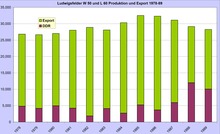
The W50 was exported to more than 40 countries in 240 country-specific models. The export rate was up to 70 percent in the 1980s. In countries such as Czechoslovakia , the Soviet Union , Romania , Hungary , Bulgaria , Nicaragua , Poland , Vietnam , Ethiopia , Angola and Mozambique , it was part of the street scene long after its production ended and in some cases until today. During the First Gulf War (1980–1988), the W50 was in use in both Iran and Iraq (especially in military versions), meaning that captured vehicles could be used immediately by either side. Iraq also used the W50 in the Second Gulf War (1990/1991). The remaining stock (more than a thousand vehicles) was sold worldwide by an entrepreneur in Heiligengrabe in the 1990s . Vietnam also replenished its stocks of W50 at that time, which are still in daily use.
The focus on export led to a shortage of vehicles within the GDR; therefore, military vehicles that were decommissioned and not exported by the NVA were used in the economy.
literature
- Christian Suhr: GDR trucks 1945–1990. Motorbuchverlag, 2005, ISBN 3-613-02535-3 .
- Christian Suhr: Truck from Ludwigsfelde. Verlag Kraftakt, 2015, ISBN 978-3-938426-18-0 .
- Günther Wappler: The braked truck. The trucks W50 and L60 from Ludwigsfelde . Publishing company Bergstrasse, Aue 2003.
- Günther Wappler: History of Zwickau and Werzeit commercial vehicle construction . Publishing company Bergstrasse, Aue 2002.
- Frank-Hartmut Jäger: IFA cab from Ludwigsfelde. The history of fire engines on the W 50 and L 60 (= fire service archive ). Verlag Technik, Berlin 2001, ISBN 3-341-01287-7 .
- Frank Rönicke: IFA W50 / L60 - 1965–1990. A documentation (= Schrader type chronicle ). Motorbuch-Verlag, Stuttgart 2013, ISBN 978-3-613-03592-8 .
- Ulf Hoffmann: Chapter 14. With old, big, heavy GDR dream IFA W50 truck to the holy Baikal . Self-published, Frankenberg / Sa. 2009, ISBN 978-3-00-024755-2 .
- Uwe Schmidt: 50 years of IFA W 50 . Börde-Museum Burg Ummendorf, Ummendorf 2015, ISBN 978-3-9804912-1-1 .
Web links
Individual evidence
- ^ Flatbed truck of the GDR type IFA W 50 LA / A. Retrieved June 16, 2020 .
-
↑ Technical data of the IFA W50 as a tractor unit ( memento from July 7, 2016 in the web archive archive.today )
LF 16 - W50 , Uckermärkisches Feuerwehrmuseum Kunow - ↑ W 45 LAF forward control truck. In: Automotive Technology . 9/1962, pp. 370-371.
- ↑ a b c Hussar ride in the Nép stadium. In: Märkische Allgemeine. On the way in the state of Brandenburg, November 7, 2008, p. V1.
- ↑ Werner Steinmetz, Albert Heber, Wilfried Geiger: The 100-year history of the IFA industrial park Nordhausen: engine era. IFA-Museum Nordhausen, accessed on July 13, 2015 .
- ^ Flatbed truck of the GDR type IFA W 50 LA / A. Retrieved June 16, 2020 .
